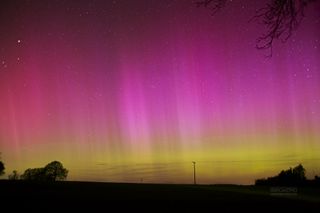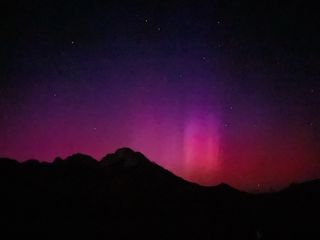A powerful solar storm hit Earth on April 23 at 1:37 PM EDT (1737 GMT) and sparked a spectacular aurora show around the world.
Geomagnetic storms are disturbances Earth’s magnetic field Caused by solar material from Coronal mass ejection (CME) — large ejections of plasma and magnetic fields from Sun’s atmosphere. This particular geomagnetic storm was triggered by a CME that left the Sun on April 21.
The geomagnetic storm peaked as a severe G4 on the 5-grade scale US National Oceanic and Atmospheric Administration (NOAA) (opens in new tab) To assess the severity of Space weather events
Related: Solar activity may increase 1 year earlier than thought. Here’s what it means for us
During solar storms, energetic particles from The sun Slam in Earth’s atmosphere At speeds of up to 45 million mph (72 million kph) and our planet’s magnetic field funnels the particles toward the poles. The supercharging of molecules in Earth’s atmosphere triggers colorful spectacles, commonly known as the aurora borealis (Northern Lights) and lower latitudes for the aurora australis (southern lights).
This time, sky watchers around the world were treated to a dazzling aurora borealis display that reached as far south as Colorado and New Mexico. In Europe, the aurora was seen as far south as France and Germany. At the other end of the scale, the aurora australis was observed as far north as the central west of New South Wales, Australia.
Landon Moller (Twitter @landon_wx (opens in new tab)) captured not only the aurora over Apple River, Illinois, US, but also a possible Lyrid meteorite!
“I was running a timelapse on my camera at the time to capture the dancing aurora,” Moeller told Space.com in an email. “Suddenly a bright white/blue meteor flashed through pillars of light burning from east to west for about 4-5 seconds and a great plume of smoke billowed out. It was incredible!”
Moller’s luck continued throughout the night, as the photographer managed to snap another Lyrid meteor streaking across an aurora-drenched sky.
Astrophotographer Ben Brotherton (Twitter @bbroastro (opens in new tab)) took this impressive photograph from his backyard in Herefordshire, West Midlands, UK.
“I was absolutely shocked at how bright and vivid it was on my camera,” Brotherton told Space.com in an email.
“I have seen the aurora before, as recently as a month ago, but this time the pillars of light were clearly visible”
(opens in new tab)
Alan Trona (Twitter @AlDarkSkyWales (opens in new tab)) A stunning image from the Rigos Mountain, South Wales, UK show the moon And Venus shines to the left of the conjunct aurora light show.
“The night sky exploded into life around 11 p.m [BST] And the most amazing auroral display emerged in front of me,” Trow told Space.com in an email.
“It was great to have the colors on camera to the people gathered nearby and then show the amazing display in front of us! It made up for the stargazing experience that was canceled due to clouds at our original destination.” Trow continued.
(opens in new tab)
Alice Hwange (Twitter @MsAliceHwang) was surprised to see the Northern Lights in southern California.
My husband and I were camping in the Owens Peak Wilderness in the Southern Sierra. After the sun went down and we started seeing a pink glow in the sky, we almost couldn’t believe our eyes!” Hwang told Space.com in an email.
“It was incredible and surreal to see pillars so high in the sky at this latitude!” Hwang continued.
(opens in new tab)
Despite the clouds, Edwin Mabonga (Twitter @Edwinmab1 (opens in new tab)) managed to capture a fascinating mix of aurora scenes in Southland, New Zealand.
“I took these images as part of an aurora photography class I was running.” Mabonga told Space.com in an email.
Mbonga invited people who wanted help taking photos to meet him outside his house. He was approached by a mother and her three children as well as a 60-year-old woman with their phones.
“They were both amazed that their phones could take photos of the aurora and happy to see their first aurora,” Mabonga continued. “All in all a very satisfying evening for me despite the clouds.”
Caitlin Moore saw a beautiful aurora display from Madison, Wisconsin, US
“The incredible green and pink/purple color of the ionized gases was only apparent on long exposures, but even the naked eye could see a faint, glowing light on the horizon,” Moore said in an email to Space.com”.
“We are so accustomed to the glare and light pollution of the air, with the happy helping of high, misty clouds coming off the lakes, that the fact of seeing the aurora at all at this latitude, is much less of such a striking and exquisite color and structure. A testament to the power of solar activity,” continued Moore.
Many skywatchers took to Twitter to showcase their incredible aurora photographs.
The bright city lights of Calgary, Canada couldn’t stop the beautiful aurora light show captured by Kyle Britton (Twitter @KyleBrittainWX (opens in new tab)) above the city skyline.
Unreal! Seeing the aurora over the bright city lights of Calgary was memorable! #yyc #AuroraBorealis #NorthernLights pic.twitter.com/S1CbUmoTafApril 24, 2023
Auroras were also seen over western Kazakhstan and were shared on Twitter by Ahot. @worst_raccoon (opens in new tab))
Aurora lights last night over West Kazakhstan region (51 latitude) @NightLights_AM #AuroraBorealis pic.twitter.com/WEHeNxEgsGApril 24, 2023
We can expect more extreme space weather events like this powerful geomagnetic storm as the Sun builds toward its zenith. 11-year solar activity cycleExpected to happen in 2025.
Inspired by these photographs and want to know how you can increase your chances of capturing the next aurora show? you can find Where and how to photograph the auroras With our helpful guide. For more detailed advice, check out our guide to the best equipment for aurora photography, including our recommendations for cameras, lenses and tripods. Or, if you’re just starting out in the field and want to know what you should buy, read through our article on the best cameras for astrophotography.
Follow us @Spacedotcom (opens in new tab)or on Facebook (opens in new tab) And Instagram (opens in new tab).
#Severe #solar #storm #hits #Earth #sparks #spectacular #auroras #world #PHOTOS





